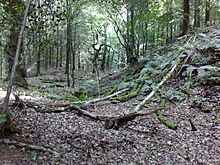Battle of Peonnum facts for kids
Quick facts for kids Battle of Peonnum |
|||||||
|---|---|---|---|---|---|---|---|
 Remains of an old fort called Kenwalch's Castle near Penselwood, showing its banks and ditches. |
|||||||
|
|||||||
| Belligerents | |||||||
| West Saxons | Britons | ||||||
| Commanders and leaders | |||||||
| Cenwalh | |||||||
The Battle of Peonnum was an important fight that happened around the year 660 AD. It was fought between the West Saxons, led by their king Cenwalh, and the Britons who lived in what is now Somerset, England. The Saxons won a big victory, which helped them take control of a large part of Somerset. We are not exactly sure where the battle took place.
Contents
Saxon Expansion in England
For a while, the border between the West Saxons and the Britons in Somerset was along a large ditch called the Wansdyke. This border was set after the Battle of Deorham in 577 AD, when the Saxons took over Bath.
Later, in 652 AD, the Saxon king Cenwalh pushed past this border at the Battle of Bradford on Avon.
Cenwalh's Return and Victory
King Cenwalh had to leave his kingdom for a short time after a disagreement with another king, Penda of Mercia. When he returned, he continued his attacks on the British tribes. Around 658 AD, his army met the Britons in a major battle at a place called Peonnum.
The Saxons won this battle. King Cenwalh then moved his army west through the Polden Hills all the way to the River Parrett. This victory allowed the Saxons to take over eastern and central Somerset. Some historians, like Geoffrey Ashe, believe Cenwalh might have wanted to gain control of the important Glastonbury Abbey, which was in this area.
Further Saxon Gains
The River Parrett remained the border for a few more years. Then, between 681 and 685 AD, another Saxon king, Centwine of Wessex, defeated the British King Cadwaladr of Gwynedd and his allies. This allowed the Saxons to take over the rest of Somerset, reaching the Bristol Channel.
Later, King Ine made the Saxon rule even stronger and expanded their lands into Devon.
Where Did the Battle Happen?
The name "Peonnum" comes from the old word pennum, which means "at the penns". The word penn is an old Celtic word meaning "head" or "top". It was often used to describe a "hill" or "peak".
You can still find "Pen" in many place names in this area today. For example, Penselwood (which was called Penna in the Domesday Book), Pinhoe, or Pen Beacon in Devon. There's also a place called Penn near Yeovil. Even one of the highest points in the Mendip Hills is called Pen Hill. This makes it tricky to know the exact spot of the battle.
See also

